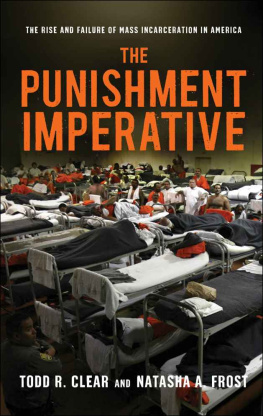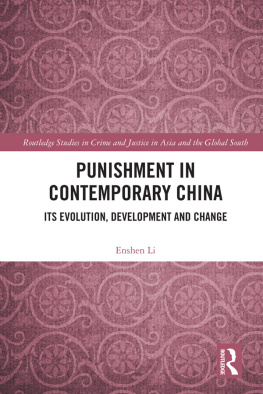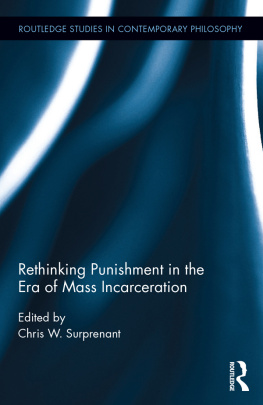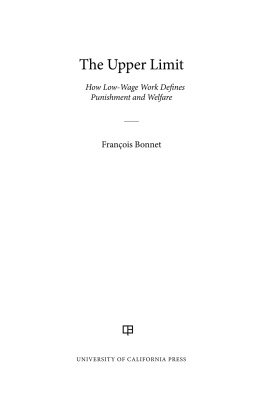THE PUNISHMENT IMPERATIVE
The Punishment Imperative
The Rise and Failure of Mass Incarceration in America
Todd R. Clear and Natasha A. Frost

NEW YORK UNIVERSITY PRESS
New York and London
www.nyupress.org
2014 by New York University
All rights reserved
References to Internet websites (URLs) were accurate at the time of writing.
Neither the author nor New York University Press is responsible for URLs that
may have expired or changed since the manuscript was prepared.
LIBRARY OF CONGRESS CATALOGING-IN-PUBLICATION DATA
Clear, Todd R.
The punishment imperative: the rise and failure of mass incarceration in America / Todd R.
Clear and Natasha A. Frost.
pages cm
Includes bibliographical references and index.
ISBN 978-0-8147-1719-6 (cl: alk. paper)
1. ImprisonmentUnited States. 2. CorrectionsUnited States. 3. Criminal justice,
Administration ofUnited States. I. Frost, Natasha. II. Title.
HV9471.C574 2014
365.973dc23
New York University Press books are printed on acid-free paper, and their binding materials
are chosen for strength and durability. We strive to use environmentally responsible
suppliers and materials to the greatest extent possible in publishing our books.
Manufactured in the United States of America
c 10 9 8 7 6 5 4 3 2 1
Also available as an ebook
For Jaeli and Harlow Adriennethat they might be part of the generation that brings about an end to mass incarceration.
CONTENTS
ACKNOWLEDGMENTS
In the academic world, much goes into the order of authorship, particularly for important works such as books. Although we have published this book with the authors listed alphabetically by last name, we emphasize here that we contributed equally to this book from conception through completion. Anyone who knows us knows that we work so well together because we each bring a different set of skills to every project, and so we each acknowledge the important contribution that the other made to seeing this book come to life. The gestation period was extended. We started writing this book before Natashas daughter was even conceived she will soon turn three. Clearly, some time has passed since we first proposed this book to NYU Press, and so we first and foremost thank our NYU Press editor, Ilene Kalish, for her endless patience and her unwavering support. Although we are sure that at times she thought she might never see the final manuscript, Ilene never once lost enthusiasm for the project.
That so much time passed was actually quite fortuitous because much changed between year-end 2008, when we first proposed the book and the overall incarceration rate was still increasing annually, and year-end 2012, when we have seen gradual, but steady, declines in prison populations for several years in a row. Subtle but persistent changes in incarceration-rate trends allowed us to rethink the core argument of this book in a way that would not have been possible had we met our initial publication schedule, or the one after that, or the one after that. We thank an anonymous but extremely helpful reviewer for his or her comments on the first complete version of the manuscript. Those comments allowed us to rethink the books structure and ultimately to make the end the beginning.
As is often the case, the central ideas in this book reflect work that we have been doing together and separately for a number of years now. In many ways, this book represents a book-length expansion of an article that we first published several years ago (Natasha A. Frost and Todd R. Clear, Understanding Mass Incarceration as a Grand Social Experiment, Studies in Law, Politics, and Society, 47 (2009), 15991). The original argument made in our Studies article shows up throughout the book, but selected portions form the foundation of represents a revised version of a chapter written for a policy reader (Natasha A. Frost, Reentry as a Process Rather Than a Moment, in K. Ismaili [ed.], U.S. Criminal Justice Policy: A Contemporary Reader[Boston: Jones and Bartlett, 2011], 15982).
There are so many who have contributed in important ways over the years to the development of our thinking around the problem of mass incarcerationwe could not possibly thank them all. A handful who certainly deserve mention include Michelle Alexander, Jim Austin, Katherine Beckett, Eric Cadora, David Garland, Michael Jacobson, Jim Lynch, Shadd Maruna, Marc Mauer, Debbie Mukamal, Joan Petersilia, Jonathan Simon, Michael Tonry, Jeremy Travis, Loic Wacquant, and Bruce Western.
Natasha would like to especially thank the members of the junior faculty writing group at NortheasternKatya Botchkovar, Carlos Cuevas, Kevin Drakulich, Amy Farrell, Jake Stowell, and Greg Zimmermanfor their helpful comments on early versions of some of the chapters in this book (and for allowing her to regularly crash the junior faculty writing group sessions post-tenure). Special thanks also go to Nicole Rafter, who serves as the mentor for the writing group, and who helps us stay on track when sessions start to go scarily awry. Suffice it to say, criminology would be a much more exciting field if this group were responsible for titling manuscripts.
We close by acknowledging the love and support of our families and friends. The writing of a book is time-consuming and can be drainingnot just for its authors but also for those who have to share time and space with them. For some reason, Dina and Bob put up with us through it all. When they grow tired of listening, we turn to others. In many ways, Todd has been trying to end mass incarceration since before it even really began, so he could not possibly acknowledge all those who have suffered through his explanations of concentrated disadvantage, coercive mobility, and the impacts of incarceration on individuals, families, and communities. He thanks them all for hearing him out even when they disagreed. Natasha is quite certain that her closest friend, Lisa McLaughlin, will be the first (and perhaps only) personal friend to read this book from beginning to end and looks forward to the spirited debates that will almost certainly follow. She thanks Lisa in particular for her love, support, and friendship over the past several years. She also remembers her brother-in-law, Andy Ellison, whose life ended far too soon while she was writing this book, and stands in awe of her sister Andrea and their kids, Austin, Tyler, and Isabel, for their strength and resolve in a time of overwhelming loss and grief.
Finally, our youngest kids, Jaeli and Harlow, to whom this book is dedicated, offered welcome distraction when the words just werent coming. Our love for you knows no bounds.
1
The Beginning of the End of the Punishment Imperative
Americas criminal justice system has deteriorated to the point that it is a national disgrace. Its irregularities and inequities cut against the notion that we are a society founded on fundamental fairness. Our failure to address this problem has caused the nations prisons to burst their seams with massive overcrowding, even as our neighborhoods have become more dangerous. We are wasting billions of dollars and diminishing millions of lives.
Senator Jim Webb, March 3, 2009
In the early 1970s, the United States embarked on a subtle change in the way it punished people for crimes. The prison population, stable for half a century, shifted upward. At first, this was little noticed, so much so that even as the number of people behind bars was inching upward, prominent criminologists were hypothesizing that there was an underlying stability to the use of imprisonment across the United States. By the end of that decade, the change was no longer subtle, and commentators began to describe a new harshness in the U.S. attitude toward crime and justice.
Next page




![Laura L. Finley - Crime and Punishment in America: An Encyclopedia of Trends and Controversies in the Justice System [2 Volumes]](/uploads/posts/book/305562/thumbs/laura-l-finley-crime-and-punishment-in-america.jpg)



